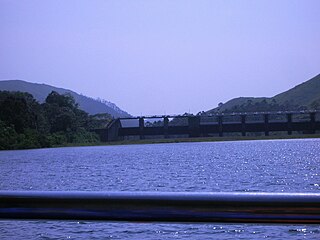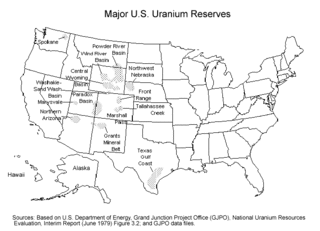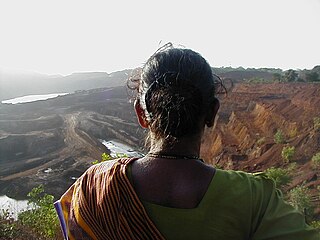Vedanta Limited is an Indian multinational mining company headquartered in Mumbai, with its main operations in iron ore, gold and aluminium mines in Goa, Karnataka, Rajasthan and Odisha.

Sand mining is the extraction of sand, mainly through an open pit but sometimes mined from beaches and inland dunes or dredged from ocean and river beds. Sand is often used in manufacturing, for example as an abrasive or in concrete. It is also used on icy and snowy roads usually mixed with salt, to lower the melting point temperature, on the road surface. Sand can replace eroded coastline. Some uses require higher purity than others; for example sand used in concrete must be free of seashell fragments.
The mining industry in India is a major economic activity which contributes significantly to the economy of India. The gross domestic product (GDP) contribution of the mining industry varies from 2.2% to 2.5% only but going by the GDP of the total industrial sector, it contributes around 10% to 11%. Even mining done on small scale contributes 6% to the entire cost of mineral production. Indian mining industry provides job opportunities to around 700,000 individuals.

Mullaperiyar Dam is a masonry gravity dam on the Periyar River of Idukki district of Indian state of Kerala. It is situated 150km south east of Kochi and 200km north east of state capital city of Trivandrum. It is located 881 m (2,890 ft) above the sea level, on the Cardamom Hills of the Western Ghats in Thekkady, Idukki District of Kerala, India. It was constructed between 1887 and 1895 by John Pennycuick and also reached in an agreement to divert water eastwards to the Madras Presidency area. It has a height of 53.6 m (176 ft) from the foundation, and a length of 365.7 m (1,200 ft). The Periyar National Park in Thekkady is located around the dam's reservoir. The dam is built at the confluence of Mullayar and Periyar rivers. The dam is located in Kerala on the river Periyar, but is operated and maintained by the neighbouring state of Tamil Nadu. Although the Periyar River has a total catchment area of 5398 km2 with 114 km2 downstream from the dam in Tamil Nadu, the catchment area of the Mullaperiyar Dam itself lies entirely in Kerala and thus not an inter-State river. On 21 November 2014, the water level hit 142 feet for first time in 35 years. The reservoir again hit the maximum limit of 142 feet on 15 August 2018, following incessant rains in the state of Kerala. In a 2021 UNU-INWEH report about ageing large dams around the world, Mullaperiyar was said to be "situated in a seismically active area with significant structural flaws and poses risk to 3.5 million people if the 100+ years old dam were to fail".

Uranium mining in the United States produced 224,331 pounds (101.8 tonnes) of U3O8 in 2023, 15% of the 2018 production of 1,447,945 pounds (656.8 tonnes) of U3O8. The 2023 production represents 0.4% of the uranium fuel requirements of the US's nuclear power reactors for the year. Production came from five in-situ leaching plants, four in Wyoming (Nichols Ranch ISR Project, Lance Project, Lost Creek Project, and Smith Ranch-Highland Operation) and one in Nebraska (Crowe Butte Operation); and from the White Mesa conventional mill in Utah.

Sterlite Copper is a subsidiary of Sterlite industries, a company owned by Vedanta Limited.
Burundi is a producer of columbium (niobium) and tantalum ore, tin ore, and tungsten ore, and some deposits of gold which are designated for export. Burundi has resources of copper, cobalt, nickel, feldspar, phosphate rock, quartzite, and rare reserves of uranium, and vanadium.
K. Ponmudi is an Indian politician and the Minister for Higher Education of Tamil Nadu, who was disqualified in 2023 after the Madras High Court convicted him in the disproportionate assets case. He was the Minister for Higher Education of Tamil Nadu from 2006 to 2011. He was born in T. Edaiyar in the Villupuram district. He has a bachelor's degree in law, a master's degree in history, political science and public Administration and a doctorate in political science. He is an alumnus of Annamalai University. Before entering professional politics, he was a professor in the Villupuram government college. He has been elected to the Tamil Nadu assembly five times. From 1989 to 1991 during Dravida Munnetra Kazhagam rule he was the Minister for Health, and from 1996 to 2001 he was the Minister for Transport and Highways. He authored a book titled Dravidian Movement in India and Black Movement in the U.S.A.

Sand theft or unauthorised or illegal sand mining leads to a generally unknown global example of natural and non-renewable resource depletion problem comparable in extent to global water scarcity. Beach theft is illegal removal of large quantities of sand from a beach leading to full or partial disappearance of the beach. In India, illegal sand mining is the country's largest organized criminal activity.

Nitte Santosh Hegde is a former judge of the Supreme Court of India, former Solicitor General of India and was Lokayukta (ombudsman) for Karnataka State of India from 2006 to 2011.

IREL (India) Limited is an Indian Public Sector Undertaking based in Mumbai, Maharashtra. It specializes in mining and refining rare earth metals.
Mining scams in India refers to a series of alleged widespread scams in various ore-rich states of India, which has generated controversy. Such issues span encroachment of forest areas, underpayment of government royalties, and conflict with tribals regarding land rights. The spill-over of the effects of legal mining into issues such as Naxalism and the distortion of the Indian political system by mixed politics and mining interests, has gained international attention.

Awaaz Foundation is a charitable trust and non-governmental organisation in Mumbai, India which builds awareness, carries out advocacy, and is involved in educational projects to protect the environment and prevent environmental pollution. It has impacted many important decisions by the government and influenced policy making in important environmental matters in India. The beneficiaries of the Foundation are the citizens of India at large.

U. Sagayam is a former career Indian civil servant who formerly served as Vice Chairman of Science City Chennai. During his career, he served both in Indian Administrative Service, as officer in the Tamil Nadu cadre and Central Secretariat Service.

The Mines and Minerals Act (1957) is an Act of the Parliament of India enacted to regulate the mining sector in India. It was amended in 2015 and 2016. This act forms the basic framework of mining regulation in India.
The granite scam was a corruption scandal that occurred in Tamil Nadu, India. It gained notoriety after former civil servant of Madurai Ubagarampillai Sagayam wrote a letter to the chief secretary of the State Industries Department on 19 May 2012, reporting major violations by many granite quarries in the Madurai district, estimating a loss of more than sixteen thousand crore rupees to the state exchequer.

The coastline of Andhra Pradesh is located on the southeastern coast of the Indian Peninsula in the Bay of Bengal and is part of the Northern Circars. With a length of 975 km, it has the third longest coastline in India after Gujarat and Tamil Nadu. The coastal corridor boasts several ports, harbors, vast stretches of sandy beaches, wildlife and bird sanctuaries, as well as fresh water lakes and estuaries.

The Goenchi Mati Movement is an environmental campaign over the issue of mining in Goa that has put forth the demand for the setting up of a "Goenchi Mati Permanent Fund" to "preserve our ancestral wealth for future generation". In the local Konkani language, the words "Goenchi Mati" literally means soil of Goa.
The Uttar Pradesh illegal sand mining scam is a political scandal relating to events that occurred in 2012–2017 during the Samajwadi Party (SP) rule. It is being investigated by the Central Bureau of Investigation (CBI) on the 2016 orders of Allahabad High Court for allowing illegal mining in 7 districts of Uttar Pradesh – Shamli, Hamirpur, Fatehpur, Siddharthnagar, Deoria, Kaushambi and Saharanpur – in violation of rules and ban by the National Green Tribunal. On 5 January 2019, the CBI raided 14 suspects in 14 locations in 7 cities across Uttar Pradesh and Delhi pertaining to this scam, and incriminating evidence was seized.












